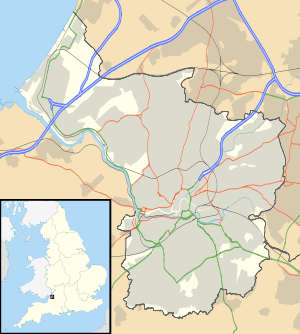St Mary le Port Church, Bristol
| St Mary le Port Church | |
|---|---|
 | |
 Location within Bristol | |
| General information | |
| Town or city | Bristol |
| Country | England |
| Coordinates | 51°27′17″N 2°35′31″W / 51.454789°N 2.592076°W |
| Completed | 15th century |
| Demolished | (partially) 24 November 1940 |
St Mary le Port is a ruined parish church in the centre of Bristol, England, situated in the area known as Castle Park.
History
St Mary le Port is said to have been founded in Saxon times after Anglo-Saxon foundations were found during archaeological excavations[1] and Saxon pottery was found nearby.[2] The church was rebuilt and enlarged between the 11th and 16th centuries.
During the 19th and early 20th centuries the church was a very popular centre of evangelical, Protestant, and Calvinist teaching within Anglicanism.

The church was bombed in the Second World War on 24 November 1940 during the Bristol Blitz. John Piper painted an evocative picture of the bombed St Mary le Port. This image appears on the 1/6 British commemorative stamp, part of a set of four paintings by British artists issued in 1968. All that remains of the church is the 15th century tower, a Grade II listed building,[3] and a Scheduled Ancient Monument[4] which during the latter years of the 20th century was surrounded by the buildings of Norwich Union and the Bank of England.
After the bombing in 1940 the congregation and their rector, William Dodgson-Sykes, moved to St John on the Wall Church, where the congregation remained, in gradually declining numbers, till this church building was closed for worship by the Church Commissioners in 1984 (after a protracted struggle by the congregation). The remaining congregation then moved to the Chapel of Foster's Almshouses, and joined the Church of England (Continuing) in 1995.[5] The C of E (Continuing) no longer lists a congregation in Bristol; some of the congregation joined with the new Free Presbyterian Church (Ulster) congregation in Horfield, Bristol.
Archives
Although many of the parish records of St Mary le Port church were destroyed when the church was bombed, some archive material is held at Bristol Archives (Refs. P. StMP) (online catalogue) and P.St JB/MLP (online catalogue) including copies of baptism, marriage and burial registers. The archive also includes records of the incumbent, churchwardens, parochial church council, charities and schools, plus deeds.
Clergy of St Mary-le-Port church
The church's clergy have included:
- William Waite, rector, born 1764, died 1842, dates at St Mary le Port unknown[6]
- William Tandey, curate 1784 - 1799 (lived 1750-1832)[7]
- James Marshall, rector 1842 - (born 23 February 1796, died 29 August 1855)[8]
- Mr Thomas, rector, resigned 1857
- Samuel Abraham Walker, rector 1857 - 1879 (born Dublin, 1809, died 30 November 1879) (source, The Gospel Magazine, January, 1880)
- James Ormiston, rector 1880 (and as at the 1901 census) (previously at Old Hill, West Midlands; editor of The Gospel Magazine from 1895–1916)
- William Dodgson Sykes, rector (as at 1940) (editor of The Gospel Magazine from 1964–1975)
- - son of William Sykes (first President of the Sovereign Grace Union)
- - Principal of the Bible Churchmen's Missionary and Theological College, later part of Trinity College, Bristol
- (Bible Churchmen's Missionary Society, now Crosslinks[9]
- - Head of the Irish Church Missions
See also
References
- ↑ M Q Smith, The Medieval Churches of Bristol, University of Bristol (Bristol branch of the Historical Association), 1970, p. 4.
- ↑ Bristol in the Early Middle Ages, University of Bristol (Bristol branch of the Historical Association), 1971, p6.
- ↑ "Tower of Church of St Mary-le-Port". Images of England. Retrieved 2007-03-22.
- ↑ "Scheduled Ancient Monuments in Bristol" (PDF). Bristol City Council. Retrieved 2007-05-07.
- ↑ C of E (Continuing) Journal
- ↑ "Waddy - Wrigley". The Methodist Archives Biographical Index. University of Manchester John Rylands University Library. Retrieved 29 June 2011.
- ↑ "Tabb - Tyerman". The Methodist Archives Biographical Index. University of Manchester John Rylands University Library. Retrieved 29 June 2011.
- ↑ "Scottish Ministers (Fasti Ecclesiae Scoticanae)". Retrieved 29 June 2011.
- ↑ "Crosslinks home page". Crosslinks. Retrieved 29 June 2011.
External links
| Wikimedia Commons has media related to St Mary le Port Church, Bristol. |
- Details of clergy
- ChurchCrawler page: detailed text & many photos
- "About Bristol" page
- "Looking at Buildings" (Pevsner) page
- Tower of Church of St Mary-le-Port grade II listed from Images of England
- BBC article on proposed 2005 development